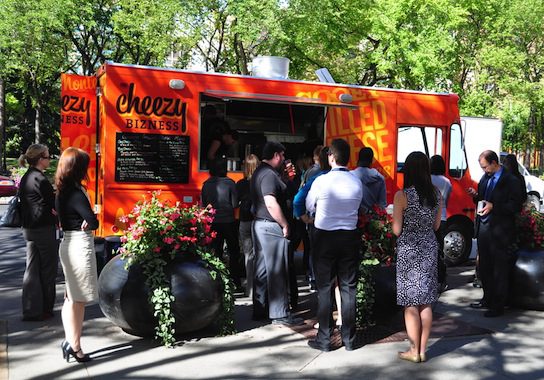Are Food Trucks Good for Community?

There is a lot of hubbub in Alexandria, Virginia at present. The town—part of one of the oldest historic districts in America—has been debating whether or not it should allow food trucks on the streets. And while citizen opposition is strong, the city has finally allowed the trucks to sell their goods: The Alexandria City Council voted 4-2 to pass a 16-month trial for food truck sales: they’ll be allowed to vend at “parks, schools, churches, farmers’ markets, and other private property over a 16-month trial period beginning July 1,” according to the Washington City Paper. On-street vending, however, is still illegal for now. The Washington Post talked to locals who are unhappy with the move:
Most of the 50 people who came to testify on the matter … [were] ready to argue against allowing food trucks in historic districts, along congested streets or in curbside competition with rent-paying restaurants.
Despite the wild popularity of food trucks in the District, Arlington County and elsewhere around the country, the Alexandrians who spoke up Saturday displayed a strong streak of not-in-my-historic-back-yard-ism.
“Woefully inappropriate,” said resident Poul Hertel, to allow food trucks in historic districts or along the GW Parkway.
“Most businesses have to apply to change the color of their signs,” said resident Bob Wood, “while every food truck I see competes to look more garish or ‘hip.’”
It may seem that a “conservative” approach to this situation would be to hold on to the norm—to ban the food trucks, in favor of more anchored, traditional restaurants. Another supposed conservative approach might be to favor a complete “free market” approach: allowing the food trucks to run riot through Old Town, setting up shop on any old cobblestone street they favor.
But a truly conservative approach must be both balanced and thoughtful—protecting the old, while embracing new measures that will complement civic life. We must consider the impact, for good and ill, that food trucks might have on Old Town Alexandria, and consider ways we could bring the most benefits, while avoiding harm to the character of the district. I think the New Urbanist approach gives us some excellent insights into the way Old Town could maximize this new market for the benefit and enjoyment of its local community.
New Urbanism is a method of urban planning that—in the words of William S. Lind—“recovers many of the practices that created the original North American settlements, the urban pattern common until the 1930s. Its designers tend to work within well-tested precedents.” He adds that this doesn’t necessitate the banning of large house lots, big garages, parking lots, and the like, but it does mean “putting them in appropriate places and providing other choices. No one is intrinsically wrong when it comes to his urban preferences. He may only be wrong in where he want to exercise them.”
All this ought to apply well to the food truck situation. Food trucks, when properly placed, can be a fun and lively addition to civic life. People living in Washington, D.C. can testify to this—the city has a wide array of food trucks, offering tasty tacos, falafel, barbecue, cupcakes, cookies, and other foods. During the lunch hour in summer months, locals and workers will fill Farragut Square. They come in groups, get their food, and sit on the grass and benches. It’s a merry event, and the food trucks help bring people together.
Food trucks could serve a similar function in Old Town. The city’s square, right on King Street, holds the local weekend farmers’ market. That event definitely adds bustle and liveliness to the square—but it’s only a weekend affair. During the week, it can seem rather empty. If a few food trucks were stationed there during the lunch hour, it might gather a crowd similar to Farragut Square’s—full of locals and workers, people who want to take advantage of the sunny weather for their lunch or dinner break.
The food trucks don’t seem likely to pull much business away from Old Town’s many restaurants. Food trucks, at least in my mind, serve a different purpose than most other restaurants on King Street. Most of the local food establishments provide a sit-down dinner, with a more relaxed dining experience. There are a few fast-food restaurants on King Street, but not many. And most of those also offer indoor eating. A food truck—by nature of its fast, outdoor features—would speak to a different sort of meal, and a different sort of eater.
However, perhaps it would be good if the food trucks are limited to squares and parks. Old Town’s streets are very narrow, and often congested as it is. Its sidewalks, similarly, offer little space—it wouldn’t take much added foot traffic to make those sidewalks a nuisance.
This would preserve the quiet, comfort, and historic walkability of Old Town, while also helping draw people to Alexandria’s vacant square. It could offer a fun activity for visitors and locals alike. As Lind put it, it’s a question of where people ought to exercise their urban preferences—a question of “putting [these preferences] in appropriate places and providing other choices.” By facilitating the food truck’s ability to gather on King Street, the city could offer a fun alternative to current dining choices, while also complementing the civic life of the city.
Comments